My original goal was to place an X button inside an edit control (it later turned out that this edit control by itself must be a part of the combo box.) I've been suggested to use this article as a guidance.
To make it look a little bit "prettier" I decided to use a toolbar for that X button instead. So I came up with the following code. Here's how the control is initialized inside the ComboBox:
//Initialization
#define EDIT_X_TOOLBAR_BTN_W 10
#define EDIT_X_TOOLBAR_BTN_H 11
//Find edit control handle using GetComboBoxInfo() API
COMBOBOXINFO cbi2 = {0};
cbi2.cbSize = sizeof(cbi2);
GetComboBoxInfo(hComboWnd, &cbi2);
HWND hEditCtrl = cbi2.hwndItem;
HINSTANCE hInst = ::GetModuleHandle(NULL);
//Create toolbar as a child of the edit control
hWndToolbar = ::CreateWindowEx(0, TOOLBARCLASSNAME, NULL,
WS_CHILD | WS_VISIBLE |
CCS_NODIVIDER | CCS_NOPARENTALIGN |
CCS_NORESIZE | CCS_NOMOVEY | TBSTYLE_FLAT | TBSTYLE_TRANSPARENT,
0, 0, 0, 0,
hEditCtrl,
(HMENU)ID_CMD_EDIT_X_TOOLBAR, hInst, 0);
::SendMessage(hWndToolbar, TB_BUTTONSTRUCTSIZE, (WPARAM) sizeof(TBBUTTON), 0);
::SendMessage(hWndToolbar, TB_SETBITMAPSIZE, 0, MAKELONG(EDIT_X_TOOLBAR_BTN_W, EDIT_X_TOOLBAR_BTN_H));
::SendMessage(hWndToolbar, TB_SETBUTTONSIZE, 0, MAKELONG(EDIT_X_TOOLBAR_BTN_W, EDIT_X_TOOLBAR_BTN_H));
//Load bitmap
TBADDBITMAP tbab = {0};
tbab.hInst = hInst;
tbab.nID = IDB_BITMAP_TOOLBAR_X;
VERIFY(::SendMessage(hWndToolbar, TB_ADDBITMAP, 1, (LPARAM)&tbab) != -1);
TBBUTTON tbbs[1] = {0};
tbbs[0].iBitmap = 0;
tbbs[0].idCommand = CMD_EDIT_X_TOOLBAR_CLOSE;
tbbs[0].fsState = TBSTATE_ENABLED;
tbbs[0].fsStyle = TBSTYLE_BUTTON;
tbbs[0].iString = -1;
VERIFY(::SendMessage(hWndToolbar, TB_ADDBUTTONS, SIZEOF(tbbs), (LPARAM)tbbs));
//Subclass edit control
oldProc = (WNDPROC)::SetWindowLong(hEditCtrl, GWL_WNDPROC, (LONG)wndProcEditCtrl);
//And redraw the edit control
::SetWindowPos(hEditCtrl, NULL, 0, 0, 0, 0,
SWP_FRAMECHANGED | SWP_NOMOVE | SWP_NOSIZE | SWP_NOACTIVATE | SWP_NOZORDER);
And this is the subclassed window proc for the edit control:
CRect rcToolbar;
LRESULT CALLBACK wndProcEditCtrl(HWND hWnd, UINT msg, WPARAM wParam, LPARAM lParam)
{
switch(msg)
{
case WM_NCCALCSIZE:
{
if(wParam)
{
//First let edit box process it
::CallWindowProc(oldProc, hWnd, msg, wParam, lParam);
RECT* pRc = (RECT*)lParam;
//Define toolbar size & move it
int nTB_w = pRc->bottom - pRc->top;
int nTB_h = nTB_w;
//Adjust the edit's client area
pRc->right -= nTB_w;
//Set toolbar rect
rcToolbar.SetRect(pRc->right, pRc->top, pRc->right + nTB_w, pRc->top + nTB_h);
//And move the toolbar
::MoveWindow(hWndToolbar, pRc->right, pRc->top, nTB_w, nTB_h, TRUE);
return 0;
}
}
break;
case WM_NCHITTEST:
{
POINT pnt;
pnt.x = GET_X_LPARAM(lParam);
pnt.y = GET_Y_LPARAM(lParam);
if(::ScreenToClient(hWnd, &pnt))
{
if(rcToolbar.PtInRect(pnt))
{
return HTBORDER;
}
}
}
break;
}
return ::CallWindowProc(oldProc, hWnd, msg, wParam, lParam);
}
The issue is that I can see that the toolbar is created (via Spy++) but it remains inactive and I don't see my button (all I get is a gray rectangle on the right):

To make sure that I can create the toolbar itself, if I change its parent window from the edit control (i.e. hEditCtrl) to the main dialog window, it is displayed (in a wrong place) and responds to clicks just fine. So my conclusion is that I must be blocking some messages to it in my subclass. The question is which ones?
Any idea what am I missing here?